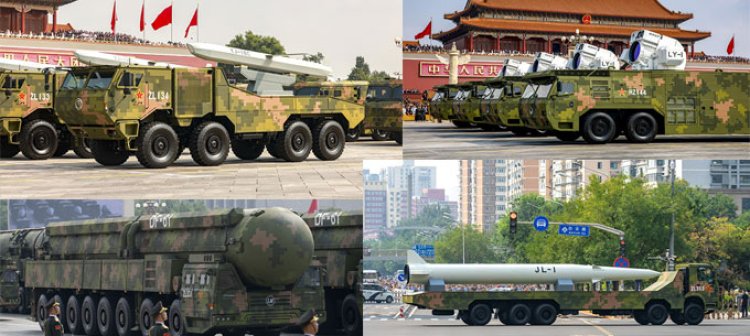Beijing’s Military Parade: China Showcases Missiles and Laser Weapons, Sends Message to the U.S.

At a grand military parade in Beijing’s Tiananmen Square, China unveiled its latest missiles and advanced laser weapons, marking a significant display of military power. The event, held to commemorate the 80th anniversary of Japan’s defeat and the end of World War II, carried a clear strategic undertone—directed at the United States.
Key Highlights of the Parade
For the first time, China presented the DF-61 intercontinental ballistic missile (ICBM) mounted on a transporter erector launcher (TEL). Details about the system remain undisclosed, but analysts believe it to be an upgraded version of the DF-41, which has a strike range of 12,000–15,000 km and can carry up to ten warheads.
Alongside this, the DF-31BJ ICBM and the JL-3 submarine-launched ballistic missile were also displayed. The JL-3 provides China with the capability to strike the U.S. mainland directly from its coastal waters.
Global-Range Missiles
China also unveiled the DF-5C ICBM, described as having “global reach.” Experts suggest it may feature orbital warhead technology and a Multiple Independently Targetable Reentry Vehicle (MIRV) system.
In addition, the JL-1 air-launched ballistic missile made its debut, drawing comparisons to Russia’s Kinzhal missile. Hypersonic CJ-1000 cruise missile launchers, YJ-18C long-range cruise missiles, and CJ-20A air-launched systems also took center stage.
Tanks and Armored Vehicles
The parade showcased China’s new ZTZ-201 main battle tank and “Type 100” combat support vehicle. Both feature hybrid powertrains, modern reactive armor, and active defense systems. The tank is equipped with a 105 mm gun said to rival 120 mm systems, along with a remotely operated machine gun module. The support vehicle integrates an automatic cannon and a reconnaissance drone system.
Laser Defense Systems
A major highlight was the presentation of advanced laser weapons. China displayed LY-1 naval laser systems and several ground-based platforms designed for air defense and missile interception. These systems are aimed at countering swarms of kamikaze drones and small aerial threats in a cost-effective manner compared to expensive missile interceptors.
Strategic Significance
Analysts stress that since China does not hold such parades annually, this year’s event is particularly significant. Vasily Kashin, director at the Center for Comprehensive European and International Studies in Moscow, remarked, “This parade is unlike anything seen in the last 15 years. It signals a new level of military capability and possible shifts in China’s doctrinal thinking.”
International observers view weapons like the JL-3 and DF-61 as clear messages to Washington and its allies, suggesting that the balance of military power in the Indo-Pacific is gradually tilting in China’s favor.






















